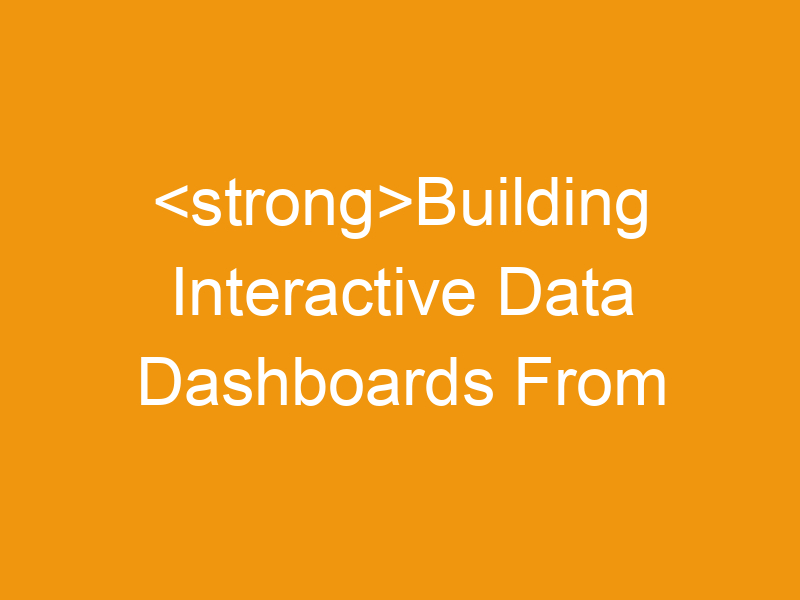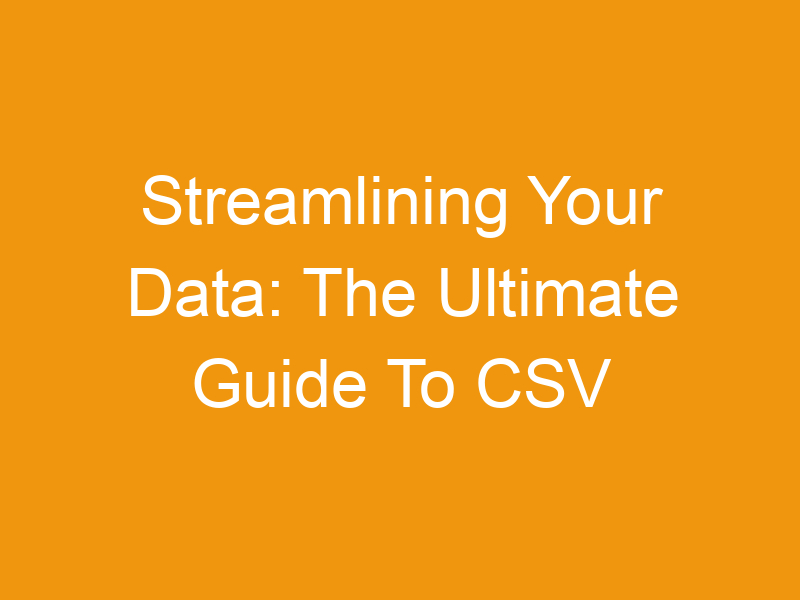Data visualization is crucial in today’s data-driven world. Turning raw data into insightful visuals is key to making informed decisions. This guide explains how to build a dashboard using data from a CSV file, covering everything from choosing the right tools to deploying your finished dashboard. We’ll walk through the entire process, even if you’re a complete beginner. You’ll learn about different approaches, common challenges, and best practices for creating effective and engaging data dashboards.
A CSV (Comma Separated Values) file is a simple text file used to store tabular data. Each line represents a row, and values within a row are separated by commas. Think of it as a spreadsheet saved in plain text format. It’s incredibly versatile and compatible with various applications.
What is a data
dashboard?
A data dashboard is an interactive visual representation of key data points and metrics. It provides a concise overview of your data, allowing you to quickly identify trends, patterns, and anomalies. Dashboards are used in various fields, from business analytics to scientific research.
Choosing the Right Tools for Dashboard Creation
Spreadsheet Software (Excel, Google Sheets)
These offer built-in charting and visualization features. Ideal for simple dashboards with limited data points. Limitations include less customization and scalability compared to dedicated tools.
Data Visualization Libraries (Python, JavaScript)
Libraries like Matplotlib, Seaborn (Python) and D3.js, Chart.js (JavaScript) provide granular control over dashboard design. Requires programming knowledge but allows highly customized visualizations.
Dedicated Dashboarding Tools (Tableau, Power BI)
These tools provide user-friendly interfaces for creating sophisticated dashboards, handling large datasets, and connecting to multiple data sources. Often subscription-based but offer advanced features.
Step-by-Step Guide: Building a Dashboard with Python and Plotly
Setting up the Environment
Install Python and necessary libraries (e.g., Pandas, Plotly). Pandas for data manipulation, and Plotly for interactive visualizations.
Loading Data from the CSV File
Use Pandas’ `read_csv()` function to load your CSV data into a DataFrame. Handle missing values and data cleaning as needed.
Data Exploration and Cleaning
Analyze your data using Pandas functions to understand its structure and identify any potential issues (e.g., missing values, inconsistencies). Clean the data appropriately for accurate visualization.
Creating Visualizations with Plotly
Plotly allows for creation of various chart types (bar charts, line charts, scatter plots, etc.). Customize the appearance, add labels, and titles.
Integrating Visualizations into a Dashboard
Plotly’s `graph_objects` module allows you to arrange multiple plots within a single dashboard layout. This provides a comprehensive overview of your data.
Benefits of Building Data Dashboards from CSV Files
Improved Data Understanding
Dashboards make complex data easier to interpret, enabling quick insights and informed decisions. The visual representation reveals trends that might be missed in raw data.
Enhanced Decision-Making
By providing a clear, concise summary of key metrics, dashboards support faster and more efficient decision-making processes across all business functions.
Increased Efficiency and Productivity
Data dashboards automate data collection, analysis and presentation, saving valuable time and resources.
Limitations and Challenges
Data Quality Issues
Inaccurate or incomplete data in the CSV file will result in misleading or inaccurate visualizations. Data cleaning is crucial.
Scalability and Performance
For extremely large datasets, processing and visualizing the data can become computationally intensive. Consider using optimized techniques or specialized tools.
Technical Skills Required
Building advanced dashboards often requires programming skills and expertise in data visualization techniques. Simple dashboards are more accessible to beginners.
Comparing Different Dashboarding Approaches
Spreadsheet Software vs. Programming Libraries
Spreadsheet software is beginner-friendly but less flexible. Programming libraries offer greater customization but demand more technical skills.
Open-Source vs. Proprietary Tools
Open-source tools provide flexibility and cost-effectiveness, while proprietary tools offer advanced features and support but are often subscription-based.
Deploying and Sharing Your Dashboard
Static vs. Interactive Dashboards
Static dashboards are images or PDFs that do not allow user interaction. Interactive dashboards allow users to filter, zoom, and explore data dynamically.
Hosting Options
Consider options like cloud services (AWS, Google Cloud), or self-hosting if you have the necessary infrastructure.
Sharing and Collaboration
Many tools allow exporting dashboards as images or embedding them in web pages or reports. Collaboration features often include user permissions and version control.
Security Considerations for Data Dashboards
Data Encryption
Encrypt your data both in transit and at rest to protect sensitive information from unauthorized access.
Access Control
Implement user authentication and authorization to restrict access to the dashboard based on user roles and permissions.
Regular Security Audits
Regularly audit your dashboard system to identify and address security vulnerabilities.
Troubleshooting Common Issues
Error Handling and Debugging
Implement robust error handling in your code to catch and handle potential problems during data loading and processing. Use debugging tools to identify and fix errors.
Performance Optimization
Optimize data processing and visualization techniques to improve the speed and efficiency of your dashboard. Techniques like data aggregation and caching can be beneficial.
Data Visualization Best Practices
Avoid overly complex charts, use clear and concise labels, and choose appropriate chart types for the data being visualized. Ensure your dashboard is accessible to all users.
Advanced Techniques for Data Dashboarding
Interactive Filters and Controls
Allow users to filter and sort data interactively, allowing them to explore different aspects of the data in detail.
Data Storytelling and Narrative Visualization
Design your dashboard to tell a story using data. Guide users through the data analysis process to highlight key insights.
Real-time Data Integration
Integrate real-time data feeds to create dynamic dashboards that reflect up-to-the-minute information.
Geospatial Visualization
Visualize geographical data using maps to highlight location-based trends and patterns.
Frequently Asked Questions
What are the common file formats for data dashboards?
CSV is a frequent choice for its simplicity. Others include JSON, XML, and database formats like SQL.
What programming languages are best suited for building data dashboards?
Python and JavaScript are leading choices, with numerous powerful libraries for data manipulation and visualization.
How can I make my dashboard more user-friendly?
Use intuitive navigation, clear labels, and consistent design principles. Consider the target audience and their technical proficiency.
What are some best practices for dashboard design?
Keep it simple, focus on key metrics, use color effectively, and ensure the information is easily accessible and understandable.
Can I build a dashboard with no programming experience?
Yes, using spreadsheet software or drag-and-drop dashboard tools makes it possible to create simple dashboards without any coding.
How do I handle large datasets for my dashboard?
Use efficient data processing techniques, consider data aggregation, and utilize tools designed for handling big data.
How do I ensure my dashboard is secure?
Implement data encryption, access control measures, and conduct regular security audits to prevent unauthorized access or data breaches.
Final Thoughts
Building a data dashboard from a CSV file is a valuable skill for anyone working with data. This guide has covered various approaches, tools, and best practices. Whether you’re a beginner using spreadsheets or a seasoned programmer utilizing Python libraries, understanding the principles of effective data visualization is crucial for extracting meaningful insights from your data. Remember that creating an effective dashboard involves more than just displaying charts; it’s about communicating a clear narrative and providing actionable insights. Experiment with different tools and techniques to find the best approach for your specific needs. Don’t be afraid to start small and gradually build your skills and your dashboards.









Leave a Reply